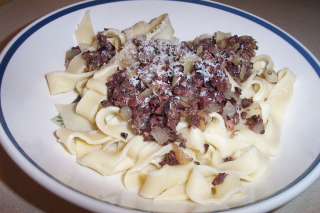Hands-on learning

I had always intended to try my hand at making fresh pasta for this blog. Pasta, especially in its dried form, is the ultimate in convenience foods: cheap, fast and easy to cook. If you can boil water, you can do pasta. Yet there's so much more to it, because fresh pasta is a completely different animal from dried, and something that few home cooks in North America make. Naturally, it seemed like a good fit with my theme.
My first attempt at homemade pasta, undertaken a few weeks ago, could best be described as "not a complete disaster." I used the recipe for fresh pasta in The Silver Spoon, which calls for a ratio of two eggs to 1 3/4 cups flour. The dough came out extremely stiff, with lots of uncombined flour, and because I'd never made pasta before, I had no idea what texture I was aiming for. We were in full-on guesswork here.
After letting it rest 15 minutes, I took the whole ball of dough and rolled it out. Naturally, I couldn't get it as thin as I wanted to without it springing back. I suppose I could have let it rest multiple times, but I was getting hungry by this point, so I just rolled it as thin as I could, cut it into wide noodles, and cooked it up. I served it with black-olive "tapenade for pasta" from the Chez Piggy Cookbook. I've included the recipe below.
While this attempt was reasonably tasty, I knew there was more to pasta making than I had managed on my own. So I took advantage of our trip into Ottawa two weeks ago to consult with a friend of mine, who makes his own pasta regularly. Because Jean-Pierre is a great guy, rather than just giving advice, he offered to walk me through the process.
The first change we made was the type of flour. I had used all purpose, because The Silver Spoon said that it was the closest approximation to Italian Type 00. Jean-Pierre favours semolina, largely because of its lower gluten content. (And because it's what he knows.) He also suggested a ratio of 100 grams of flour per egg, and thinning the dough with a little water from there.
After letting it rest, Jean-Pierre cut the ball of dough into quarters, and demonstrated how to run it through the pasta machine, a quarter at a time. I think the technique of rolling it out in smaller portions is extremely useful, even (especially?) if you're not using a pasta machine. It allows you to roll a much thinner dough over the same surface area, as well as giving you the time to dry each sheet as you roll out the next.
After they had dried a little, we took each sheet, cut it into linguine on the roller, cooked it, and served it with Jean-Pierre's homemade pesto. It was delicious.
With all the variables we changed, it's hard for me to know how much difference the pasta machine made. The process certainly seemed easier, and the dough ended up much thinner than I could ever get it by hand. But I don't think I'm ready to plunk down the cash for one just yet.
In the end, I think the hands-on approach with an experienced pasta maker was incredibly valuable. When you spend as much leisure time as I do reading about food and cooking, you sometimes forget that there are some things you just can't learn from the printed page. This was a great reminder of the advantages of having someone watch over your shoulder as you work.
When I was in Montreal on the way home, I stopped in one of the markets on St-Laurent in Petite Italie and picked up both a ravioli wheel and a bag of semolina flour. Ultimately, my heart is set on making ravioli with some braised lamb shank meat, pecorino cheese and fresh rosemary. Now that I have a better idea of how the pasta-making process should go, I don't think it'll be that much longer until I give this recipe a try.
(For a handy guide to pasta making, check out this course on eGullet.)
Tapenade for pasta
1/4 cup olive oil
1 medium onion, diced
1 lb. kalamata olives, pitted and chopped
1/4 cup capers, chopped
2 anchovy fillets, chopped (optional - leave them out if you're vegetarian)
4 cloves garlic, minced
1/2 tsp. dried thyme
2 tsp. brandy
1 Tbsp. Dijon mustard
In a frying pan, heat the oil and sauté the onion slowly until soft. Allow to cool, then mix with all the other ingredients. Toss with cooked pasta (the original recipe calls for 2 pounds) and garnish with freshly grated cheese.

0 Comments:
Post a Comment
<< Home